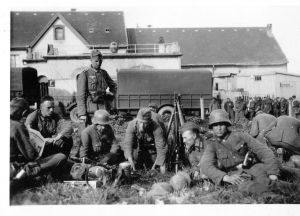Kazimierz Dolny

Kazimierz Dolny - German Troops at rest
Kazimierz Dolny is a small town in Central Poland on the right bank of the Vistula River in the county of Pulawy. After World War One, there were some 1,400 Jews in Kazimierz Dolny, almost half of this small –town’s population. Most were artisans, primarily tailors and shoemakers, merchants and providers of services to the visitors who flocked to this popular tourist destination. As the economic situation deteriorated in the 1920’s and 1930’s Jews formed professional associations and local relief organisations. They also established a free-loan fund as well as savings-and loan association. Kazimierz Dolny had chapters of Zionist parties and the Bund as well as Jewish youth movements. This small-town boasted a Jewish public library and chapters of the Maccabi and Shtern sports associations. Children attended traditional and other education institutions, a general school that provided secular education and Hebrew-language instruction, a Beit Yaakov school and a Szabasowka government primary school. On 19 September 1939, the Germans occupied Kazimierz Dolny and began to abduct Jews for forced labour. They established a Judenrat under Yaakov Halberstadt and instructed it to furnish them with forced labourers and to pay hefty ransoms. In late 1939, Jewish children were expelled from the local schools. The separate study groups that the Judenrat had been allowed to establish were shut down two months later and the synagogue was converted into a stable.
In early 1940, a new six-member Judenrat was established under Chaim Feiershein, as was a six-member Jewish Order Service, in order to maintain law and order and to provide workers for the Germans. The Kazimierz Dolny ghetto was established in the spring of 1940, with some 2,000 Jews concentrated there. Included in this figure were many Jewish refugees from Pulawy and other nearby towns and villages. The ghetto was surrounded with a barbed –wire fence, and the inhabitants were allowed to leave only for work or with special permission. A labour camp was also established in Kazimierz Dolny for about 120 Jewish and Polish forced labourers. In the winter of 1940/41, the Germans forbade Poles to enter the ghetto or trade with the Jews. As a result hunger escalated and a typhus epidemic broke out. In 1942 deportees from Czechoslovakia were transported to the labour camp.
On 25 -27 March 1942, the Jews of Kazimierz Dolny were deported to the Opole ghetto, where some were taken to the labour camp in Naleczow.Three days later on 30 March 1942 some 2,000 Jews were deported to the Belzec death camp from Opole. The labour camp in Kazimierz Dolny was liquidated in October 1943, where the few Jews who had survived were murdered.
Sources:
The Yad Vashem Encylopiedia of the Ghettos During the Holocaust Volume 1, Yad Vashem, 2009.
Y. Arad, Belzec, Sobibor, Treblinka – The Aktion Reinhard Death Camps, Indiana University Press, Bloomington and Indianapolis 1987.
Photograph - Tall Trees Archive, UK
© Holocaust Historical Society 2016

